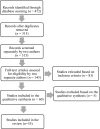Telehealth and Autism Prior to and in the Age of COVID-19: A Systematic and Critical Review of the Last Decade
- PMID: 34114135
- PMCID: PMC8191715
- DOI: 10.1007/s10567-021-00358-0
Telehealth and Autism Prior to and in the Age of COVID-19: A Systematic and Critical Review of the Last Decade
Abstract
There has been growing interest in the use of telehealth; however, the COVID-19 pandemic and the subsequent isolation and restrictions placed on in-person services have fast-tracked implementation needs for these services. Individuals with autism spectrum disorder (ASD) have been particularly affected due to the often-intensive service needs required by this population. As a result, the aim of this review was to examine the evidence base, methodology, and outcomes of studies that have used telehealth for assessment and/or intervention with children and adolescents with ASD as well as their families over the last decade. Further, the goal is to highlight the advances in telehealth and its use with this special population. A systematic search of the literature was undertaken, with 55 studies meeting inclusion criteria and quality analysis. Specified details were extracted from each article, including participant characteristics, technology, measures, methodology/study design, and clinical and implementation outcomes. Services provided via telehealth included diagnostic assessments, preference assessments, early intervention, applied behavior analysis (ABA), functional assessment and functional communication training, and parent training. Findings, although still emerging, encouragingly suggested that services via telehealth were equivalent or better to services face-to-face. Results support the benefits to using telehealth with individuals with ASD. Future research should continue to explore the feasibility of both assessments and interventions via telehealth with those having ASD to make access to assessment services and interventions more feasible for families, while acknowledging the digital divide it could create.
Keywords: ASD; Assessment; Autism; Autism Spectrum Disorder; Intervention; Telehealth.
© 2021. The Author(s), under exclusive licence to Springer Science+Business Media, LLC, part of Springer Nature.
Conflict of interest statement
The authors have no conflict of interest to declare.
Figures
References
-
- American Psychiatric Association . Diagnostic and statistical manual of mental disorders, fifth edition: DSM-5. 5. American Psychiatric Association; 2013.
Publication types
MeSH terms
LinkOut - more resources
Full Text Sources
Medical
Research Materials


